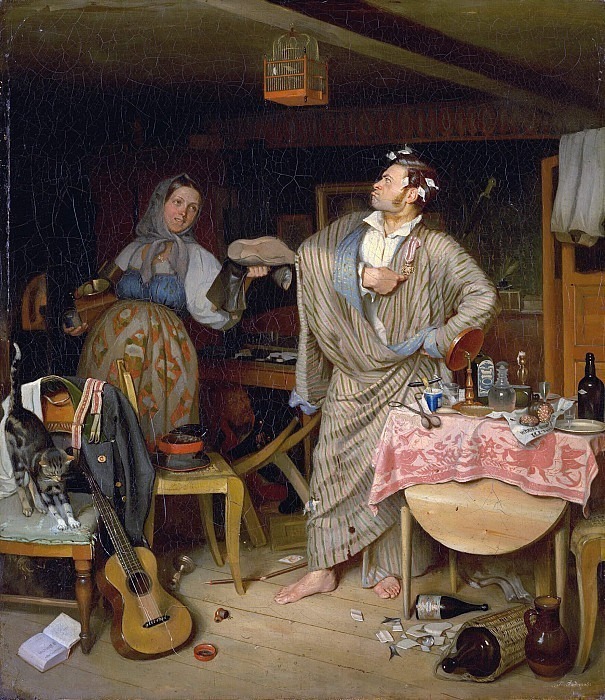Fresh cavalier. The morning of the official who received the first cross Pavel Fedotov (1815-1852)
Pavel Fedotov – Fresh cavalier. The morning of the official who received the first cross
Edit attribution
Download full size: 1770×2048 px (0,5 Mb)
Painter: Pavel Fedotov
Location: The State Tretyakov Gallery, Moscow (Государственная Третьяковская галерея).
The painting was painted in 1846. This painting by P. A. Fedotov, The Fresh Cavalier, conveys to the viewer an episode in the life of an official. The official has received his first award, the Order, and is presented to us as the main character of the painting. His pride and haughtiness attracts the eye. The artist depicted his character in a caricature that makes the viewer smile. After all, the order received by the official is the lowest award an official could receive at that time.
Description of Pavel Fedotov’s painting The Fresh Cavalier
The painting was painted in 1846. This painting by P. A. Fedotov, The Fresh Cavalier, conveys to the viewer an episode in the life of an official. The official has received his first award, the Order, and is presented to us as the main character of the painting. His pride and haughtiness attracts the eye.
The artist depicted his character in a caricature that makes the viewer smile. After all, the order received by the official is the lowest award an official could receive at that time. But the main character, a petty official, sees this award as a promotion. He dreams of a different life.
The setting in the hero’s room is not rich and explains the hero’s reaction to such a low award.
The comicality of the image is due to the contrast of his image. The painting depicts him in a huge robe, barefoot, in curlers, standing in a squalid room. The robe is wearing an award. The serious expression on his face against the background of the robe and the domestic setting brings a smile. After all, the cavalier is bragging to his maid. Most likely he has no one else to show off his award. The look on the maid’s face is condescending. She has not stopped doing her daily chores, and is standing next to the chevalier, holding a boot in her hand.
The hero’s room is small, with many things piled on top of each other. On the dining table, which is probably also a work table, lies a sausage sliced on a newspaper. There are fish bones lying under the table. Every corner of the room is a mess, things piled on top of each other. A uniform is hanging on two chairs, and there are things lying around everywhere. On one of the chairs a cat is tearing up the upholstery.
The hero’s curlers and curling tongs, which lie here on the table, speak of the hero’s desire to be fashionable and well-groomed.
But all of the hero’s things, they are not properly cared for. The hero’s image and his desire to be higher in rank than he is looks ridiculous and ridiculous. Even the cat in the chair is thin and ungroomed.
The painting "The Fresh Cavalier" gives information about the life and traditions of the 1st half of the 19th century. There is irony and human emotion in it.
Кому понравилось
Пожалуйста, подождите
На эту операцию может потребоваться несколько секунд.
Информация появится в новом окне,
если открытие новых окон не запрещено в настройках вашего браузера.
You need to login
Для работы с коллекциями – пожалуйста, войдите в аккаунт (open in new window).



















COMMENTS: 1 Ответы
ФЕДОТОВ
Развязный свежий кавалер
Сколь колоритен, столь забавен.
Аристократ навряд подавлен
Бывает. Жизнь – игра манер.
Быт густ и плотен. От него
Луч бытия едва ль страдает.
Быт на полотнах застывает,
Как прошлой жизни вещество.
You cannot comment Why?
The room is filled with various objects: an acoustic guitar leaning against a chair, a military jacket and hat on the same chair, a book lying open on the floor, a cat stretching on the chair, papers scattered on the floor, an overturned bottle in a basket. On a table near the man, there are grooming items, a mirror, and some bottles, suggesting he is in the process of getting ready. A birdcage hangs from the ceiling. The overall impression is one of a hasty or chaotic morning, perhaps after a night of celebration or revelry, given the disarray and the mans attire and adornments.
The subtext of the painting, suggested by the title Fresh cavalier. The morning of the official who received the first cross, points to a newly promoted or honored man. The fresh cavalier could imply a young, perhaps slightly vain or inexperienced man, who has just achieved a significant milestone in his official career, symbolized by the first cross (likely a medal or order of distinction). The disarray of the room and the mans disheveled state, contrasted with the womans traditional attire and perhaps subservient role (offering the boot), hint at a contrast between his newfound status and the remnants of his more humble or uninhibited past. The scene could be interpreted as a humorous and perhaps slightly critical commentary on the transition into a more formal or public life, where ones personal life might be a bit more chaotic than befitting their new public image. The artist seems to be capturing a moment of transition, where the official is perhaps still shaking off the habits of a less formal life just as he is about to embrace his new responsibilities and public persona.